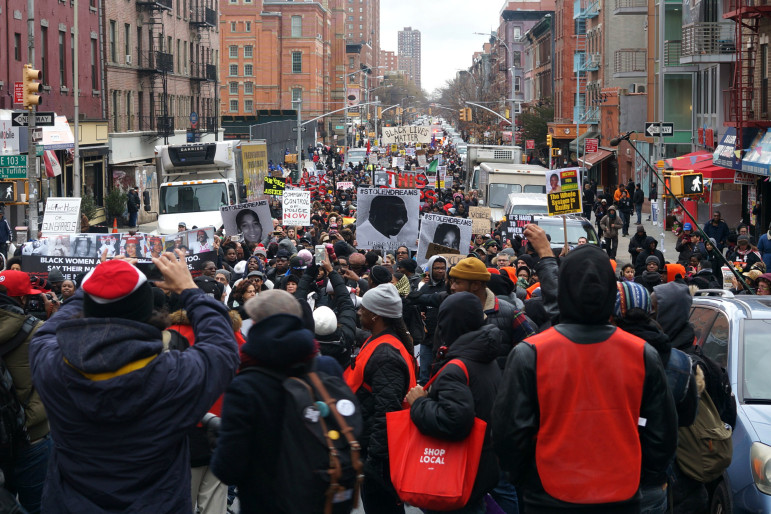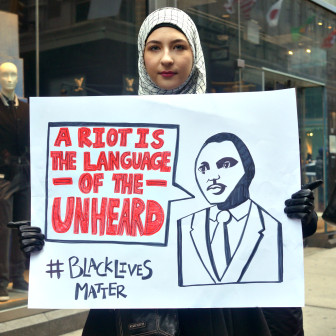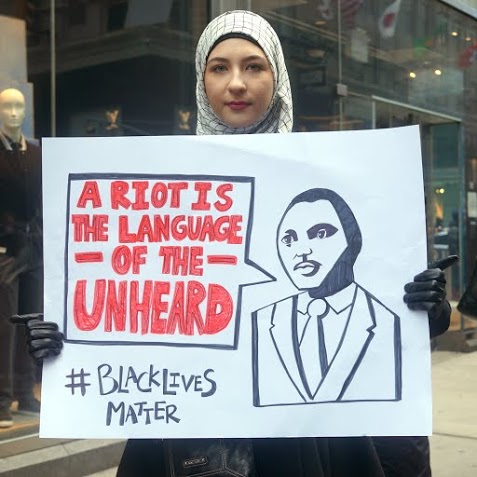
Meral Agish
At the head of the march, protesters stretch for blocks along Lexington Avenue.
NEW YORK — The image and words of Dr. Martin Luther King Jr. could be seen and heard everywhere the Dream4Justice march went, from Harlem to Midtown, Monday afternoon.
But as the marchers walked a slow and peaceful four miles over as many hours, King’s voice mixed with the protesters’ now familiar chants: “I have a dream” alongside “I can’t breathe” and “No justice, no peace.”
King’s memory brought organizers and protesters together but the marchers’ demands came from more recent deaths. In memory of Michael Brown, Eric Garner and others who had been killed by police, the march ended near the United Nations to bring attention to police brutality as a human rights issue. Marchers called for immediate policy change at the city and state levels in keeping with King’s philosophy.
“We are non-violent but we are not peaceful,” said Tamika Mallory, an organizer and board member of The Gathering for Justice. “We are upset, we are angry and we are fighting back.”
Elsewhere in the city and across the country, dozens of events commemorated Martin Luther King Jr. Day with celebrations, protests and die-ins. In New York, a separate march headed farther downtown toward the city’s civic center.
 For many young protesters at the Dream4Justice march, King provided a model of action and philosophy but also reminded them of how much work still needed to be done.
For many young protesters at the Dream4Justice march, King provided a model of action and philosophy but also reminded them of how much work still needed to be done.
Ruben Mendez, 24, of Perth Amboy, N.J., carried a poster-sized image of King, a photocopy of a painting his mother had finished just days before the march. In the painting King is surrounded by protesters with signs like “Jobs Now” and “Human Rights,” demands that remain just as relevant today as they were 50 years ago, he said.
Asked why he marched, Mendez pointed to the quote at the bottom of his poster. The excerpt, from King’s 1967 “Beyond Vietnam” speech, warned of the dangers of valuing things over people.
“We’re still marching against the triple evils of racism, against economic inequality and against the horrible issue that is war,” he said, echoing King’s words. “Dr. King’s dream is not over yet and that’s why we’re still marching.”

Meral Agish
Azra Tahirovic holds a hand-drawn portrait of King.
Dalila Tahirovic, 23, came to the march with her sister Azra, 20, from Queens to honor King’s support for the oppressed.
“We are here today as veiled white Muslim women of Caucasian background but also of a culture that has experienced genocide of its own,” she said, referring to her Bosnian heritage. King’s work has shown her the need to protest and support justice for all, she said, “especially if you have white privilege, especially if you benefit from white supremacy.”
Jarrett Lamar Hannah, 22, of Brooklyn, said he looked to King’s work for a way forward, beyond what he called an endless cycle of stigma against people of color.
“The same thing that’s happening now is the same thing that King used to talk about, it’s the same thing that Tupac [Shakur] rapped about, it’s the same thing that J. Cole and Kendrick [Lamar] now talk about,” he said. “We’re born without blank slates, we’re born tainted, not by our skin tone but by how people perceive us.”
Hannah said he also looks to the spirit of Malcolm X, whose angrier form of protest could help propel social justice movements if weariness sets in.
“We’re tired. We’re following in King’s footsteps by being patient and having peaceful protests and doing walk-ins and die-ins,” he said. “But we have the anger that Malcolm X had. We’re still upset with the system. We still want vengeance. But we don’t seek vengeance — we seek justice.”
Near the end, organizer Mallory came back to the podium to thank the crowd.
“It is great that we are here celebrating Dr. King,” she said. “But we have our own work to do. Dr. King is gone. You and I are the Kings of today.”
